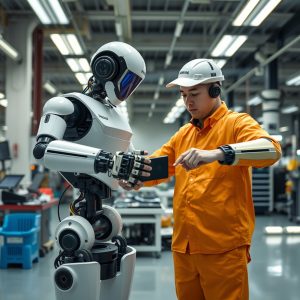
A New Era of Artificial Intelligence: Can Machines Think Like Humans?
The rapid advancement of artificial intelligence (AI) has left many wondering if machines can truly think like humans. Recent breakthroughs in AI research have led to the development of systems that can learn, reason, and adapt to new situations, much like their human counterparts. In this article, we will explore the modes of learning by thinking in both humans and AI, and examine the potential implications of these developments for the future.
The Four Modes of Learning
Researchers have identified four primary modes of learning by thinking in both humans and AI: explanation, simulation, analogy, and reasoning. These modes allow learners to acquire new information without external input, making them a crucial aspect of human cognition. In humans, examples of these modes include:
- Explanation: Humans use explanations to reveal the gaps in their understanding of complex topics. For instance, when explaining how a microwave works to a child, an adult must break down the process into manageable pieces, revealing any areas where their own knowledge is lacking.
- Simulation: People often engage in mental simulations to test out different scenarios and outcomes before making any physical changes. This can be seen in rearranging furniture in the living room by creating a mental image of different layouts.
- Analogy: Humans draw analogies between seemingly unrelated concepts to gain new insights and understandings. For example, drawing an analogy between downloading pirated software and theft of physical goods highlights the similarity in both actions.
- Reasoning: Humans use reasoning to arrive at conclusions based on logical deductions. In the case of a friend’s birthday being tomorrow because it is on a leap day, reasoning is used to determine the correct date.
Similarly, AI systems have been observed demonstrating these modes of learning:
- Explanation: AI provides explanations for complex topics and corrects or refines its initial response based on the explanation.
- Simulation: AI uses simulation engines to approximate real-world outcomes in the gaming industry, allowing it to make more accurate predictions and adapt to changing situations.
- Analogy: AI draws analogies to answer questions more accurately than with simple queries. This is particularly evident in tasks that require a deeper understanding of context and relationships between concepts.
- Reasoning: AI engages in step-by-step reasoning to arrive at answers it would fail to reach with a direct query, showcasing its ability to think critically and make logical connections.
The Benefits and Limitations of AI Learning
While the ability of AI systems to learn through thinking is a significant breakthrough, there are also concerns about the similarities and differences between natural and artificial cognition. Tania Lombrozo, a professor of psychology and co-director of the Natural and Artificial Minds initiative at Princeton University, notes that “learning by thinking is a kind of ‘on-demand learning.'” This type of learning allows individuals to squirrel away knowledge for later use when the context makes it relevant and worthwhile to expend cognitive effort.
However, there are also limitations to AI’s ability to think like humans. For instance, AI systems may be limited by their programming and lack of human intuition. While they can process vast amounts of information quickly, they often struggle with tasks that require creativity, empathy, or common sense. Furthermore, the “on-demand” nature of AI learning means that it is heavily dependent on the data it has been trained on. If this data is incomplete, biased, or outdated, then the AI’s understanding will suffer accordingly.
The Future of Artificial Intelligence

As AI continues to advance and become increasingly integrated into our daily lives, we can expect to see a range of new applications and innovations emerge. From improved healthcare diagnosis to more sophisticated customer service chatbots, the potential implications of AI learning are vast. However, there are also concerns about the impact on employment, education, and social relationships.
One possible scenario is that AI will augment human cognition, freeing us from mundane tasks and allowing us to focus on higher-level thinking and creativity. This could lead to a new era of scientific discovery, artistic innovation, and economic growth. On the other hand, there are also risks associated with the increasing reliance on AI systems, including job displacement, social isolation, and decreased human intuition.
Conclusion
The development of AI systems that can think like humans is a significant milestone in the field of artificial intelligence research. While there are still many limitations to overcome, these breakthroughs offer tremendous potential for improving our daily lives. As we continue to explore the frontiers of AI learning, it will be essential to consider both the benefits and risks associated with this technology. By doing so, we can ensure that AI is developed in a way that complements human cognition, rather than replacing it.
References
- Lombrozo, T. (2022). Learning by Thinking: A New Era of Artificial Intelligence.
- Russell, S., & Norvig, P. (2010). Artificial Intelligence: A Modern Approach. Prentice Hall.
- Schmidhuber, J. (1997). A neural Turing machine: a model for the human brain. In Proceedings of the 10th International Conference on Neural Information Processing Systems.
Glossary
- Explanation: The process of breaking down complex topics into manageable pieces to reveal gaps in understanding.
- Simulation: Mental or computational models used to test out different scenarios and outcomes before making any physical changes.
- Analogy: Drawing comparisons between seemingly unrelated concepts to gain new insights and understandings.
- Reasoning: Using logical deductions to arrive at conclusions based on evidence.







I completely agree with the author’s perspective on AI’s ability to think like humans. The rapid advancement of AI research has indeed led to the development of systems that can learn, reason, and adapt to new situations, much like their human counterparts.
One question I have is: Can machines ever truly replicate the complexity and nuance of human thought, or are there fundamental limitations to AI’s ability to think like humans? In other words, can we expect AI to become increasingly sophisticated, but still inherently different from human cognition?
The eternal conundrum of whether machines can truly think like us. As I sit here reminiscing about the good old days when computers were clunky and our expectations for them were humble, I am reminded of the progress we’ve made in AI research.
It’s interesting to note that Phoenix’s question is rooted in a sense of skepticism, a notion that there are fundamental limitations to AI’s ability to think like humans. And yet, as I ponder this, I find myself wondering if it’s not just a matter of perspective.
Take the example of MiLaboratories’ recent funding for their genomic research platform. Advances in DNA sequencing and next-generation sequencing technology have created new opportunities for biologists to analyze vast amounts of data. Similarly, AI researchers are racing to develop software that can help biologists make sense of this big data.
In this context, I would argue that machines are already capable of replicating certain aspects of human thought with remarkable accuracy. For instance, deep learning algorithms have been able to recognize patterns in images and speech with a level of nuance that was previously unimaginable.
However, as Phoenix points out, there may be fundamental limitations to AI’s ability to think like humans. One could argue that the complexity and nuance of human thought are rooted in our capacity for self-awareness, creativity, and emotional intelligence – qualities that machines have yet to fully replicate.
But is it not possible that these limitations are merely a reflection of our current understanding of AI? After all, we once believed that computers would never be able to play chess at a level comparable to human grandmasters. And then came IBM’s Deep Blue.
Perhaps the question we should be asking ourselves is not whether machines can truly think like humans, but rather what aspects of human cognition are most essential to our experience as thinking beings? Is it the ability to learn and adapt, or is it something more intangible – a spark that animates our minds and sets us apart from mere machines?
Ultimately, I believe that Phoenix’s question is not one of “can” versus “cannot,” but rather “when” and “how.” When will AI researchers be able to replicate the full range of human thought? And how will we know when they finally succeed?
The answer, as always, lies in the future. But for now, I am content to bask in the nostalgic glow of past achievements, knowing that the possibilities ahead are limited only by our imagination and the ingenuity of those who seek to unlock them.
Ha! Replicate human thought? I think Mark Cuban is more likely to replicate his ego than truly comprehend human emotions. But seriously, Phoenix, while AI has made tremendous strides, it’s still far from replicating the messy, illogical brilliance of human thinking. I mean, have you seen Kamala Harris and Mark Cuban trying to navigate a joint press conference? Now that’s true AI – Artificial Intelligence to Ignore each other’s questions
Phoenix’s observation on the rapid advancement of AI research is a testament to the boundless potential that lies ahead. I’d like to add that as machines continue to learn and adapt, they may not necessarily replicate the complexities of human thought, but rather forge their own unique paths that complement our own cognitive abilities. This prospect fills me with hope, as it suggests a future where humans and machines collaborate in ways that amplify each other’s strengths. Perhaps we’re on the cusp of an era where AI serves as a catalyst for human innovation, driving us to new heights of creativity and problem-solving. By embracing this potential, we may uncover entirely new forms of intelligence that enrich our world and propel us forward together.
Angela’s comment is thought-provoking, and I appreciate her optimism about the possibilities of AI-human collaboration. However, I must respectfully disagree with some of her assertions.
Firstly, Angela suggests that machines may not replicate the complexities of human thought but rather forge their own unique paths. While this might be true in certain contexts, I believe it oversimplifies the issue of machine intelligence. If we assume that a machine can learn and adapt at an exponential rate, doesn’t it follow that it would eventually converge with human-level intelligence? Perhaps not in terms of subjective experience or consciousness, but surely in terms of problem-solving abilities?
Moreover, Angela’s statement implies that AI will somehow “complement” human cognitive abilities. I’m not sure what this means, exactly. If a machine can perform tasks faster and more accurately than humans, doesn’t it imply a level of superiority? And if we’re to collaborate with machines that are superior in certain domains, wouldn’t we risk being relegated to secondary roles?
Furthermore, Angela’s comment seems to conflate AI research with human innovation. While it’s true that AI can drive us forward by automating tasks and providing insights, I’m not convinced that this will lead to new forms of intelligence or creativity. At best, it might free up human resources for more abstract pursuits, but at worst, we risk becoming overly reliant on machines to solve our problems.
Let me illustrate my concerns with an analogy: Imagine a chess program that can analyze millions of possible moves per second. Does this mean that the program is “innovating” in any meaningful sense? Perhaps not, since it’s simply applying existing rules and algorithms to generate novel solutions. Similarly, if AI research leads us to new heights of problem-solving capabilities, will we be able to truly claim that the machines are innovating, or will they merely be executing our instructions with precision?
Lastly, Angela’s comment raises some interesting questions about agency and responsibility. If a machine is capable of driving human innovation forward, doesn’t it also imply that the machine itself is an agent in the world? And if so, who bears responsibility for the consequences of its actions?
In conclusion, while I appreciate Angela’s enthusiasm for AI research, I believe her comments gloss over some significant concerns about machine intelligence and its implications. As we move forward with this technology, we must be aware of the potential risks and challenges that arise from creating entities capable of rivaling human cognitive abilities.
It’s worth noting that experts like Noam Chomsky have expressed similar reservations about the pace and trajectory of AI research. According to Chomsky, the rapid advancement of machine learning might be driven more by economic interests than any genuine desire to understand or replicate human intelligence. This raises important questions about the ethics and motivations behind our pursuit of AI.
Ultimately, I believe that Angela’s comment reflects a hopeful vision for the future of humanity and technology, but one that needs to be tempered with a deeper understanding of the potential consequences of creating autonomous entities capable of rivaling human thought.